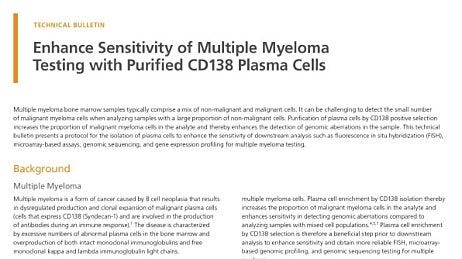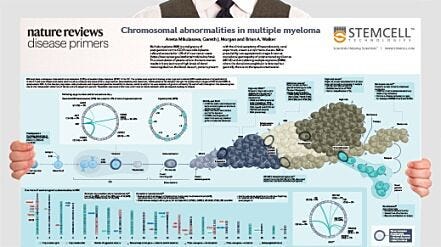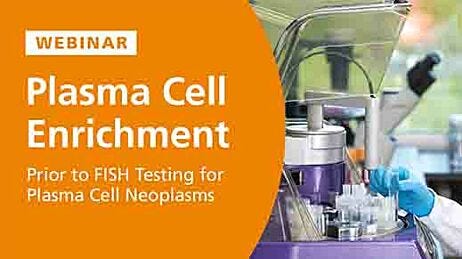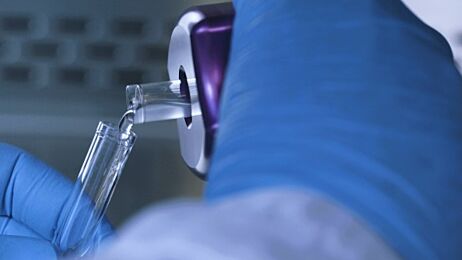Champion Your Cancer Diagnostics with Plasma Cell Enrichment
Introducing the EasySep™ Human Bone Marrow CD138 Positive Selection Kit
What role do in vitro diagnostic (IVD) devices play in your laboratory’s pre-analytical workflow? Using IVD products will reduce the validation burden of your laboratory as they are specifically intended for use with diagnostic assays and have been designed, manufactured, validated to meet the applicable regulatory requirements.
Learn more about why using an IVD product is important for your laboratory >
The EasySep™ Human Bone Marrow CD138 Positive Selection Kit is our newest IVD product and has been classified by the US Food and Drug Administration (FDA) as a first-of-its-kind IVD device for hematopoietic cell enrichment. The kit is also an IVD medical device in Australia, Canada, the EU, and the United Kingdom.
The kit is designed to effectively and reliably provide plasma cell enrichment of bone marrow samples from patients diagnosed with multiple myeloma. Multiple myeloma is an incurable cancer accounting for approximately 2% of all cancers in the United States1 and can be challenging to diagnose due to the variable or low frequencies of CD138+ plasma cells in bone marrow samples. Therefore, enrichment of plasma cells is recommended upstream of fluorescence in situ hybridization (FISH) testing by the National Comprehensive Cancer Network® (NCCN Guidelines Version 2.2020 Multiple Myeloma).
Read More About Multiple Myeloma
Featured Training Program
Free, On-Demand Course for CD138+ Plasma Cell Enrichment
Learn to process bone marrow samples and isolate CD138+ plasma cells to increase the sensitivity in FISH testing for multiple myeloma in our step-by-step course.
How Does the EasySep™ Human Bone Marrow CD138 Positive Selection Kit Work?
The EasySep™ Human Bone Marrow CD138 Positive Selection Kit targets CD138+ plasma cells for positive selection using an antibody that recognizes CD138 surface antigens and magnetic particles for cell separation. Designed for use with the “The Big Easy” EasySep™ Magnet and EasySep™ Buffer (IVD) to isolate cells without the use of columns, the kit includes the antibodies and magnetic particles required to label CD138+ cells for separation. The easy-to-follow protocol results in labeled CD138+ cells that remain in the tube after unlabeled cells are poured off. This kit is indicated for in vitro diagnostic use by laboratory professionals; the end user is responsible for determining whether the product is suitable for their specific application(s).
How Does EasySep™ Cell Separation Work?
Cells are targeted for either removal (negative selection and depletion) or positive selection using antibody complexes directed to specific cell surface antigens. The antibody complexes link targeted cells to EasySep™ magnetic particles. Labeled cells are pulled to the sides of the tube when the sample is placed in an EasySep™ cell separation magnet, while untouched cells can be simply poured or pipetted off into a new tube.
See how EasySep™ cell separation technology provides greater CD138+ cell purity following enrichment of bone marrow samples from multiple myeloma patients with the EasySep™ Human Bone Marrow CD138 Positive Selection Kit.
Frequently Asked Questions
What is an in vitro diagnostic (IVD) product and why is this important for my laboratory?
What other products are required for use with this IVD EasySep™ product?
Can the EasySep™ Human Bone Marrow CD138 Positive Selection Kit be used with other cell separation magnets or instruments?
Can the EasySep™ Human Bone Marrow CD138 Positive Selection Kit be used for samples other than bone marrow?
Does STEMCELL Technologies partner with diagnostic manufacturers or end-users?
How can I learn more about preparing bone marrow samples and performing CD138+ plasma cell isolation?
Additional Resources for CD138+ Cell Isolation and Multiple Myeloma Testing
References
- Cancer Stat Facts: Myeloma. National Cancer Institute Surveillance, Epidemiology and End Results program [Online]. [https://seer.cancer.gov/statfacts/html/mulmy.html] (accessed Feb 12, 2023)
- Huff CA & Matsui W. (2008) Multiple myeloma cancer stem cells. J Clin Oncol 26(17): 2895–900.
- Pugh TJ et al. (2018) Assessing genome-wide copy number aberrations and copy-neutral loss-of-heterozygosity as best practice: An evidence-based review from the Cancer Genomics Consortium working group for plasma cell disorders. Cancer Genet 228–229: 184–96.
- Kjeldsen E. (2016) Identification of Prognostically Relevant Chromosomal Abnormalities in Routine Diagnostics of Multiple Myeloma Using Genomic Profiling. Cancer Genomics Proteomics 13(2): 91–127.
- Glaskova L et al. (2017) CD138 Enrichment Strategy and Results of Chromosome Genomic Array Testing (CGAT) for Multiple Myelomas. Cancer Genet 214: 43.
- Shin SY et al. (2012) Application of an immune-magnetic cell sorting method for CD138-positive plasma cells in FISH analysis of multiple myeloma. Int J Lab Hematol 34(5): 541–6.
- NCCN Clinical Practice Guidelines in Oncology (NCCN Guidelines®): Multiple Myeloma [Online], Version 2.2020. [https://www.nccn.org/professionals/physician_gls/recently_updated.aspx] (accessed Oct 23, 2019)





